a) The complete flag is shown below.
b) The middle one-third of the flag is coloured in white.
c) The Ashoka chakra is in the middle of the white part.
d) One-third portion the flag is coloured in green.
e) The flag is divided into 3 equal parts. Each of the three colours is 1/3 of the flag. But in the white portion the Ashok chakra has been draw. So, the white colour is less than 1/3 of the flag.
NCERT Solutions for Maths Class 5 Chapter 4 - Parts and Wholes
The chapter Parts and Wholes focuses on dealing with fractions and wholes. It covers the concept of how fractions work and how to add and subtract them. It helps the students to understand how to operate with fractions.
Download PDF For NCERT Solutions for Maths Parts and Wholes
The NCERT Solutions for Maths Class 5 Chapter 4 - Parts and Wholes are tailored to help the students master the concepts that are key to success in their classrooms. The solutions given in the PDF are developed by experts and correlate with the CBSE syllabus of 2025-2026. These solutions provide thorough explanations with a step-by-step approach to solving problems. Students can easily get a hold of the subject and learn the basics with a deeper understanding. Additionally, they can practice better, be confident, and perform well in their examinations with the support of this PDF.
Download PDF
Access Answers to NCERT Solutions for Maths Class 5 Chapter 4 - Parts and Wholes
Students can access the NCERT Solutions for Maths Class 5 Chapter 4 - Parts and Wholes. Curated by experts according to the CBSE syllabus for 2025–2026, these step-by-step solutions make Maths much easier to understand and learn for the students. These solutions can be used in practice by students to attain skills in solving problems, reinforce important learning objectives, and be well-prepared for tests.
Parts and Wholes
a) Draw a rectangle of length 9 cm and width 6 cm. Divide it into three equal parts and complete the flag.
b) The top one-third of our flag is saffron (or orange). What is the colour of the middle one-third of the flag?
c) Where will you draw the Ashoka chakra?
d) How much of the flag will you colour green?
e) Is the white colour now less than 1 3 of the flag? Why?

This is the flag of Myanmar, our neighbour.
a) Is blue more than one-fourth of the flag or less?
b) Guess how much of the flag is red. Is it more than 1/2 ? Is it more than three-fourths?

c) Observe the given flag, the blue portion is less than one-fourth of the flag.
d) The blue portion is less than one-fourth of the flag. Therefore, the red portion of the flag is more than 1/2 ,even it is more than three- fourths..
a) Now look at this flag. How much of it is black?
b) The green part of the flag can be written as.........
c) Is red less than one-third of the flag? Why?

a) The flag is divided into three equal parts. Each part is one-third of the flag. Therefore, the one-third of the flag is black.
b) Since each part is one-third of the flag, the green part of the flag is one-third of the flag.
c) There is a white emblem in the red coloured portion. Therefore, the red colour is less than one-third of the fag.
Practice Time
B) Colour the hats
a) Colour 1/3 of the hats red. Colour three-fifth hats blue.
b) How many hats did you colour red?
c) How many hats did you colour blue?
d) What part of the hats are not coloured?

a) There are 15 hats in the given picture. Therefore,
1/3 of 15 = 1/3 X 15 = 5
Three-fifth of 15 = 3/5 X 15 =3X15/5 =9
So, colour 5 hats in red, and 9 hats in blue
b) Five hats are coloured in red.
c) Nine hats are coloured in blue.
d) One out of fifteen hats is not coloured. Therefore,1/15 hats are not coloured.

A) Chocolate bar
a) Manju had a chocolate. She gave one-fourth of it to Raji, one-third to Sugatha and one-sixth to Sheela. She ate the remaining part. How many pieces of chocolate did each get?
b) What part of the chocolate did Manju eat?
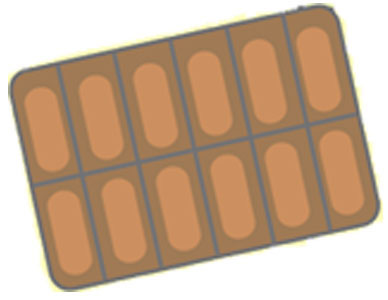
a) The chocolate is divided into 12 equal pieces.
Step 1: Since Raji got one-fourth of the whole chocolate, multiply 1/4by 12 to find the share of Raji.
1/4 X 12 = 12/4 = 3
Therefore, Raji got 3 pieces of the chocolate.
Step 2: Since Sugandha got one-third of the whole chocolate, multiply 1/3 by 12 to find the share of Sugandha.
1/3 X 12 = 12/4 = 4
Therefore, Sugandha got 4 pieces of the chocolate.
Step 3: Since Sheela got one-sixth of the whole chocolate, multiply 1/6 by 12 to find the share of Sheela.
1/6 X 12 = 12/6 = 2
Therefore, Sheela got 2 pieces of the chocolate.
Step 4: Since Manju ate the remaining part, add the shares of each of her friends and then subtract the result from 12 to find the share of Manju.
4 + 3 + 2 = 9 12 – 9 = 3 Therefore, Manju got 3 pieces of the chocolate.
b) Since Manju got 3 pieces out of 12 pieces of the chocolate, divide 3 by 12 to find the portion of the whole chocolate that Manju ate.
3/12 = 1/4
Therefore, Manju got one-fourth of the chocolate.
Patterns in Parts
Look at grid A again. Is the grid coloured:
a) 1/2 Blue ,1/2 white?
b) 2/4 Blue ,2/4 white?
c) 3/8 Blue ,3/8 white?
d) 4/8 Blue ,4/8 white?
Mark (![]() ) on the wrong answer.
) on the wrong answer.
Observe the grid A, it is coloured 8/16 blue, and 8/16 white.
Express 8/16 as equivalent fractions by dividing the numerator and denominator with the same number.
8/16 = 8#8/ 16#8 = 1/2
8/16 = 8#4/ 16#4 = 2/4
8/16 = 8#2/ 16#2 = 4/8
Therefore, the wrong answer is:
c) 3/8 Blue , 3/8 White (![]() )
)
Draw grids of 16 squares and make patterns with
a) 2/8 red,1/2 yellow, 1/4 green
b) 3/16 red,5/16 yellow, 1/2 green
a) Find the number of squares to be coloured in red, yellow, and green.
Number of red-coloured squares = 2/8 X 16 = 4
Number of yellow-coloured squares = 1/4 X 16 = 8
Number of green-coloured squares = 1/4 X 16 = 4
Therefore, draw a grid of 16 squares and colour 4 squares in the red, 8 squares in the yellow, and 4 squares in the green.
b) Find the number of squares to be coloured in blue, red, and green.
Number of blue-coloured squares = 3/16 X 16 = 3
Number of red-coloured squares = 5/16 X 16 = 5
Number of green-coloured squares = 1/2 X16 =8
Therefore, draw a grid of 16 squares and colour 3 squares in the blue, 5 squares in the red, and 8 squares in the green.
Make different patterns by colouring some squares in the grids B, C, D. What part of the grid did you colour? What part of the grid remained white? Write.

Do as directed. Answers may vary. A sample answer is:

Ramu’s vegetable field
Ramu wanted to give these vegetables to his friends. He gave Aboobacker one-fifth of these tomatoes and 1/3 of the potatoes. Srija got 2/5 of the tomatoes and 3/6 of the potatoes. Nancy got the rest of these vegetables. Circle Aboobacker’s share in blue. Circle Srija’s share in yellow.
How many potatoes and tomatoes did Nancy

There are 18 potatoes and 20 tomatoes in the given picture. See the given figure.
Step 1: Find the Aboobacker’s share as:
One-fifth of the tomatoes =1/5 X 20 = 20/5 = 4tomatoes.
1/3 of the potatoes = 1/3 X 18 =18/3 = 6 potatoes
Step 2: Find Srija’s share as:
2/5 of the tomatoes = 2/5 X 20 = 2 X 20/5 = 8 tomatoes
3/6 of the potatoes = 3/6 X 18 = 3 X 18/6 = 9 potatoes
Now, circle Aboobacker’s share in blue, and Srija’s share in yellow.
Since Nancy got the rest of the vegetables, count the vegetables that are not circled to find the share of Nacy.
Therefore, Nancy got 3 potatoes and 8 tomatoes.

Ramu’s vegetable field has 9 equal parts. What vegetables does he grow?
1) Which vegetable grows in the biggest part of his field? What part?
2) On what part of the field does he grow potatoes?
3) What part of the field is used to grow spinach? What part is used for brinjals?
4) Now you write some questions by looking at this picture.

Observe the given picture. Ramu grows chillies, brinjals, tomatoes, spinach, and potatoes.
1) Observe the given picture. Out of 9 parts, tomatoes are in 3 parts. That is
3/9 = 1/3
Therefore, Ramu grows tomatoes in the biggest part of his field. That is one-third of the field.
2) The potatoes are in 2 out of 9 parts. That is 2/9 of the field.
Therefore, he grows potatoes in the two-ninth part of the field.
3) Spinach is in 1 out of 9 parts. Therefore, he grows spinach in the one-ninth part of the field.
Brinjals are in 2 out of 9 parts. Therefore, he grows brinjals in the two-ninth part of the field.
4) Do it by yourself. Answers may vary. A sample question is: Which vegetable grows in the smallest part of his field? What part?
Guess and Check
What part of each shape is coloured? First guess the answer, then check.



Guess by yourself. The correct answer is.
1)1/8 of the shape is coloured.
2) One-sixth of the shape is coloured.
3)2/9 of the shape is coloured.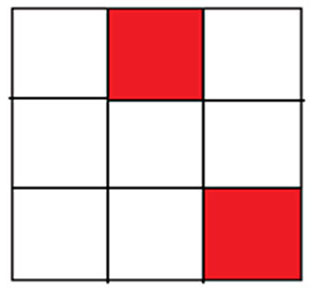
4) 4/15 of the shape is coloured.
Coloured Parts
Complete these:
1.
This circle is divided into two equal parts. Out of .............. equal parts one part is coloured blue.
2.
Here the circle is divided into................ equal parts. Out of .............. equal parts, ............... parts are coloured blue.
3.
Here the circle is .........................................................
4.
Here the circle is ...............................................................
1) This circle is divided into two equal parts. Out of two equal parts one part is coloured blue.
2) Here the circle is divided into four equal parts. Out of four equal parts, two parts are coloured blue.
3) Here the circle is divided into six equal parts. Out of six equal parts, three parts are coloured blue.
4) Here the circle is divided into eight equal parts. Out of eight equal parts, four parts are coloured blue.
Therefore,1/2 = 2/4 = 3/6 = 4/8
Cutting the Halwa
Ramesh bought a piece of halwa for his children Ammu and Anu.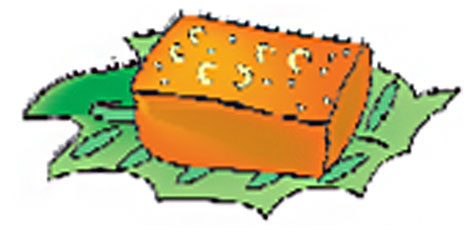
He divided it equally for them.
a) Each will get ________ part of halwa.
b) “This piece is too big. We can’t eat it”, they said. So he divided the pieces into half again. Now how many pieces will Ammu get?
What part of the halwa is it?
c) “Make it even smaller, Dad” they asked. So he again cut the halwa into smaller pieces. “Ok, thank you, Dad.”
Now how many pieces will each get?
d) What part of the halwa is each piece now?
e) If Ramesh had cut the halwa into 6 equal parts how many pieces each have got? Look at your answers and write:
1/2 = — = — = — = — = —
a) Each will receive 1/2 part of halwa.
b) Since the halwa is divided into four equal pieces, Ammu will get two pieces. Since Amu will get 2 out of four pieces, it is 2/4 of the halwa.
c) Since the halwa is divided into eight equal pieces, each one will get 4 pieces.
d) Since the halwa is divided into eight equal pieces, each piece is 1/8 of the halwa.
e) If the halwa is divided into six equal pieces, then each one will get three pieces.
1/2 = 2/4 = 4/8 = 3/6 = 8/16 = 16/32
Parts of the Strip
a) Look at the picture. Write what part of the strip is each green piece. Write the part for a piece of each colour.
b) How many one-fourths will make a half?
c) How many 1/8 will make 1/4 ?
d) How many 1/8 are in 1/2?
a) The green strip is divided into 4 equal parts. Therefore, each part is 1/4 of the whole green strip.
Part of a piece of each colour is shown below.
b) There are two one-fourths in one half.
c) There are two 1/8 in 1/4.
d) There are four 1/8 in 1/4.

Patterns
Look at the square.
a) What part is coloured blue?
b) What part is green?

a) We can divide the given square in 16 equal squares as shown below.
Two out of 16 squares are coloured blue. Therefore,
2/4 or 1/8 part is coloured blue.
b) One out of the sixteen squares is coloured green. Therefore,
1/16 part is coloured green.

From a Part to the Whole
1) This show 1/5 petals of a flower. Complete the flower by drawing the other petals.
2)The picture shows one-third of the blades of a fan. Complete the picture by drawing the other blades.
3) Half of the blades of another fan are shown here. Complete the picture by drawing the other half. How many blades have you drawn?
1) The complete flower is shown below.
2) The complete fan is shown below.
3) Two blades a drawn that are half of the total blades. So, we need to draw two more blades. The complete fan is shown below.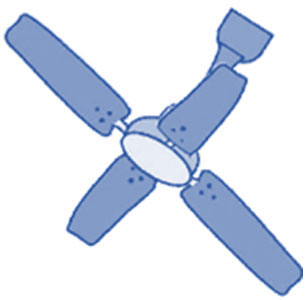
Rupees and Paise
Arun’s Time Table
Sleeping: One third of a day
a) Use different colours to show:
Playing: One eighth of a day
Studying: 1/4 of a day
b) How many hours does Arun take for:
Sleeping? ____ hours.
Studying? ____ hours.
Playing? ____ hours.
c) What part of the day does he use for other activities?

a) There are 24 hours in a day. Therefore, One-eight of a day = 1/8 x = 24/8 = 3 hours.
1/4 of a day = 1/4 X 24 = 24/6 =6 hours
There are 24 hours in a day, and the strip for Arun’s time table is divided into 24 equal parts. Therefore, each part represents one hour. Using different colours, colour 3 parts for playing, and 6 parts for studying.
b) From part a), he takes:
8 hours for sleeping
6 hours for studying
hours of playing.
c) The uncoloured boxes of the strip in part a) shows the time for other activities.
There are 7 uncoloured boxes. Therefore, he uses 724 of a day for other activities.

a) How many 50-paise coins will make one rupee?
b) Is 50 paise half of one rupee?
c) How many 25-paise coins will make one rupee?
d) 25 paise is _________ part of one rupee.
e) 20 paise is _________ part of one rupee.
f) How many 10 paise will make one rupee?
a) Two 50-paise coins will make one rupee.
b) Since there are two 50-paise coins in one rupee, 50 paise is half of one rupee.
c) There are four 25-paise coins in one rupee.
d) Since there are four 25-paise coins in one rupee, 25 paise is one fourth part of one rupee.
e) There are five 20-paise coins in one rupee. Therefore, 20 paise is one-fifth of one rupee.
f) There are ten 10-paise coins in one rupee.
School Magazine
Have you heard of Kumbhakarna, the brother of Ravana? He is famous for sleeping for half a year.
a) Most people sleep about 8 hours a day. Then what part of a day is it?
b) So what part of a year do they sleep? A person 60 years old must have slept _______ years!!!
a) There are 24 hours in a day. Therefore, 8 hours is
8/24 = 1/3f a of day
Hence, most people sleep about one-third of a day.
b) Since most people sleep about one-third of a day, they also sleep one-third of a year.
A 60 years old person must have slept for
1/3 X 60 = 1 X 20 = 20years
A school has decided to bring out a magazine every quarter of the year. How many magazines will they have in a year? If they want to print it at the end of each quarter of a year, which are the months for printing? Mark the number for those months.

A quarter is one-fourth of the whole. Since there are 12 months in one year, a quarter of one year is
1/4 X = 12 = 3 months.
Therefore, they will have four magazines in one year. The number for those months are marked.

Keerti’s Shopping List
At the railway station a) What time is the train expected to come today?
b) Nazia gets off at a station after 2 1/2 hours from this station. What time will she get off?
c) Shaji will take 5 hours to reach Ernakulam by this train. At what time will he reach there?
a) The correct time for the train is quarter to seven, or 6 3/4 hours, but the train is late by half an hour. Therefore, the expected arrival time for the train is
6 + 3/4 + 1/2 = 24/4 + 3/2 + 2/4
= 29/4 =7 1/4
Hence, the expected arrival time for the train is quarter past seven. b) The expected arrival time of the train is 7 1/4 hours and Nazia gets off after 2 1/2 hours. Therefore, Nazia will get off at
7 1/4 + 2 1/2 = 7 1/4 +2 2/4 = 9 3/4 hours
Or quarter to nine.
c) Shaji will reach Ernakulam by this train after 5 hours. Expected time of the arrival of the train is 7 1/4 hours.
Expected time at which Shazi will reach Ernakulam is:
7 1/4 + 5 = 12 1/4 hours.
Latha bought a pencil and a pen for seven and a half rupees. She gave Rs 10/–. The shopkeeper gave back the money in half and quarter rupees. What are the coins she got?
Latha spent Rs 15/2 on a pencil and a pen.
The total amount returned the shopkeeper is
10 - 7 1/2 = Rupee two and half.
Following are the possible combinations of half and quarters for rupee two and half.
One half-rupee coin and eight quarter-rupee coins.
Two half-rupee coins and six quarter-rupee coins.
Three half-rupee coins and four quarter-rupee coins.
Four half-rupee coins and two quarter-rupee coins.
Raheem has to travel 1 1/4 km to reach school. What distance does he travel to go to school and come back home?
First convert 1 1/4 in fraction as:
1 1/4 = 1 X 4 + 1 / 4 = 5/4
The distance from his home to school is 5/4 km. Therefore, the total distance covered in going to school and coming back to the home is
2 X 5/4 = 10/4 = 2 1/2 Km

Look at the yellow price list.
a) How much does 2 kg of tomato cost?
b) How much does 1/2 kg of tomato cost?
c) Kiran wants 2 1/2 kg of tomato. How much will it cost?
d) How much does 3 1/2 kg potato cost?
e) What is the price of 1 1/4 kg of carrot?
f) He bought a gourd of weight 4 3/4 kg and it costs?
g) Look at the shopping list in Keerti’s hand. How much will she have to pay to buy all of these?
h) Make a bill of your own for vegetables you want to buy. Find the total money you will have to pay.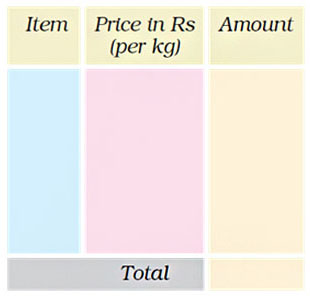
a) Price of 1 kg tomato is Rs12. Therefore,
price of 2 kg tomato = 12 × 2 = Rs 24.
b) Price of 1 kg of tomato is Rs 12. Therefore,
price of 1/2 kg tomato = 1/2 X 12 = Rs 6
c) First convert 2 1/2 in fraction as:
2 1/2 = 2 x 2 + 1/2 = 5/2
The price of 1 kg tomato is Rs 12, Therefore,
price of 5/2 Kg tomato = 5/2 X 12 = Rs 30.
Hence, the price of 2 1/2 kg tomato is Rs 30.
d) First convert 3 1/2 in fraction as:
3 1/2 = 3 X 2 + 1 /2 = 7/2
The price of 1 kg potato is Rs 10. Therefore,
price of 7/2 kg of potato = 7/2 X 10 = Rs 35.
Hence, the price of 3 1/2 kg potato is Rs 35.
e) First convert 1 1/4 in fraction as:
1 1/4 = 1 X 4 + 1 / 5 = 5/4
The price of 1 kg carrot is Rs 18. Therefore,
price of 5/4 kg carrot = 5/4 X 18 = 22 1/2 = Rs 22.50
Hence, the price of 1 1/4 kg carrot is 22 rupees and 50 paise.
f) First convert 4 3/4 in fraction as:
4 3/4 = 4 X 4 + 3 / 4 = 19/4
The price of 1 kg gourd is Rs 8. Therefore,
price of 19/4 kg gourd = 19/4 X 8 = Rs 38.
g)
| Items | Price per kg (in rupees) | Total Price |
| Potato 2 1/4 kg | 10 | Rs 22.50 |
| Carrot 3 3/4 kg | 18 | Rs 67.50 |
| Gourd 1 1/2 kg | 8 | Rs 12 |
Total Rs 102
h) Do it by yourself.
Admissions Open for
Admissions Open for
Frequently Asked Questions
The NCERT solution for Class 5 Chapter 4: Parts and Wholes is important as it provides a structured approach to learning, ensuring that students develop a strong understanding of foundational concepts early in their academic journey. By mastering these basics, students can build confidence and readiness for tackling more difficult concepts in their further education.
Yes, the NCERT solution for Class 5 Chapter 4: Parts and Wholes is quite useful for students in preparing for their exams. The solutions are simple, clear, and concise allowing students to understand them better. They can solve the practice questions and exercises that allow them to get exam-ready in no time.
You can get all the NCERT solutions for Class 5 Maths Chapter 4 from the official website of the Orchids International School. These solutions are tailored by subject matter experts and are very easy to understand.
Yes, students must practice all the questions provided in the NCERT solution for Class 5 Maths Chapter 4: Parts and Wholes as it will help them gain a comprehensive understanding of the concept, identify their weak areas, and strengthen their preparation.
Students can utilize the NCERT solution for Class 5 Maths Chapter 4 effectively by practicing the solutions regularly. Solve the exercises and practice questions given in the solution.
CBSE Schools In Popular Cities
- CBSE Schools in Bangalore
- CBSE Schools in Mumbai
- CBSE Schools in Pune
- CBSE Schools in Hyderabad
- CBSE Schools in Chennai
- CBSE Schools in Gurgaon
- CBSE Schools in Kolkata
- CBSE Schools in Indore
- CBSE Schools in Sonipat
- CBSE Schools in Delhi
- CBSE Schools in Rohtak
- CBSE Schools in Bhopal
- CBSE Schools in Aurangabad
- CBSE Schools in Jabalpur
- CBSE Schools in Jaipur
- CBSE Schools in Jodhpur
- CBSE Schools in Nagpur
- CBSE Schools in Ahmednagar
- CBSE School In Tumkur











